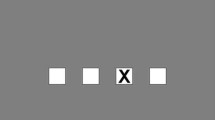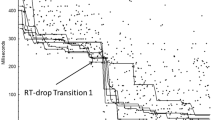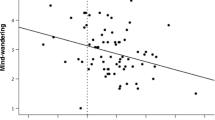Abstract
Implicit learning, the type of learning that occurs without intent to learn or awareness of what has been learned, has been thought to be insensitive to the effects of priming, but recent studies suggest this is not the case. One study found that learning in the serial reaction time (SRT) task was improved by nonconscious goal pursuit, primed via a word search task (Eitam et al. in Psychol Sci 19:261–267, 2008). In two studies, we used the goal priming word search task from Eitam et al., but with a different version of the SRT, the alternating serial reaction time task (ASRT). Unlike the SRT, which often results in explicit knowledge and assesses sequence learning at one point in time, the ASRT has been shown to be implicit through sensitive measures of judgment, and it enables sequence learning to be measured continuously. In both studies, we found that implicit learning was superior in the groups that were primed for goal achievement compared to control groups, but the effect was transient. We discuss possible reasons for the observed time course of the positive effects of goal priming, as well as some future areas of investigation to better understand the mechanisms that underlie this effect, which could lead to methods to prolong the positive effects.






Similar content being viewed by others
References
Aarts H (2007) On the emergence of human goal pursuit: the nonconscious regulation and motivation of goals. Soc Pers Psychol Compass 1:183–201
Aarts H, Custers R, Holland RW (2007) The nonconscious cessation of goal pursuit: when goals and negative affect are coactivated. J Pers Soc Psychol 92:165–178
Bargh JA, Chen M, Burrows L (1996) Automaticity of social behavior: direct effects of trait construct and stereotype activation on action. J Pers Soc Psychol 71:230–244
Bargh JA, Gollwitzer PM, Lee-Cahi A, Barndollar K, Trotschel R (2001) The automated will: nonconscious activation and pursuit of behavioral goals. J Pers Soc Psychol 81:1014–1027
Bennett IJ, Howard JH Jr, Howard DV (2007) Age-related differences in implicit learning of subtle third-order sequential structure. J Gerontol B Psychol Sci Soc Sci 62B:98–103
Cleeremans A, Destrebecqz A, Boyer M (1998) Implicit learning: news from the front. Trends Cogn Sci 2:406–416
Custers R, Aarts H (2005) Positive affect as implicit motivator: on the nonconscious operation of behavioral goals. J Pers Soc Psychol 89:129–142
Dijksterhuis A, Aarts H, Bargh JA, van Knippenberg A (2000) On the relation between associative strength and automatic behavior. J Exp Soc Psychol 36:531–544
Eitam B, Hassin RR, Schul Y (2008) Nonconscious goal pursuit in novel environments—the case of implicit learning. Psychol Sci 19:261–267
Gamble KR, Cummings TJ Jr, Lo SE, Ghosh PT, Howard JH Jr, Howard DV (2014) Implicit sequence learning in people with Parkinson’s disease. Front Hum Neurosci 8:563. doi:10.3389/fnhum.2014.00563
Hassin RR, Bargh JA, Zimerman S (2009) Automatic and flexible: the case of non-conscious goal pursuit. Soc Cogn 27:20–36
Heine SJ, Proulx T, Vohs KD (2006) The meaning maintenance model: on the coherence of social motivations. Pers Soc Psychol Rev 10:88–110
Holland RW, Hendriks M, Aarts H (2005) Smells like clean spirit: nonconscious effects of scent on cognition and behavior. Psychol Sci 16:689–693
Howard JH Jr, Howard DV (1997) Age differences in implicit learning of higher order dependencies in serial patterns. Psychol Aging 12:634–656
Howard DV, Howard JH Jr, Japikse K, DiYanni C, Thompson A, Somberg R (2004a) Implicit sequence learning: effects of level of structure, adult age, and extended practice. Psychol Aging 19:79–92
Howard JH Jr, Howard DV, Dennis NA, Yankovich H, Vaidya CJ (2004b) Implicit spatial contextual learning in healthy aging. Neuropsychology 18:124–134
Kempf F, Brücke C, Kühn AA, Schneider G-H, Kupsch A, Chu Chen C, Androulidakis AG, Wang S, Vandenberghe W, Nuttin B, Aziz T, Brown P (2007) Modulation by dopamine of human basal ganglia involvement in feedback control of movement. Curr Biol 17:R587–R598
Kühn AA, Brücke C, Hübl J, Schneider G-H, Kupsch A, Eusebio A, Ashkan K, Holland P, Aziz T, Vandenberghe W, Nuttin B, Brown P (2008) Motivation modulates motor-related feedback activity in the human basal ganglia. Curr Biol 18:R648–R650
McCulloch KC, Ferguson MJ, Kawada CCK, Bargh JA (2008) Taking a closer look: on the operation of nonconscious impression formation. J Exp Soc Psychol 44:614–623
Nissen MJ, Bullemer P (1987) Attentional requirements of learning: evidence from performance measures. Cogn Psychol 19:1–32
Reber AS (1989) Implicit learning and tacit knowledge. J Exp Psychol Gen 118:219–235
Salamone JD, Correa M, Mingote SM, Weber SM (2005) Beyond the reward hypothesis: alternative functions of nucleus accumbens dopamine. Curr Opin Pharmacol 5:34–41
Shang J, Fu Q, Dienes Z, Shao C, Fu X (2013) Negative affect reduces performance in implicit sequence learning. PLoS ONE 8:e54693–e54693
Simon JR, Stollstorff M, Westbay LC, Vaidya CJ, Howard JH Jr, Howard DV (2011) Dopamine transporter genotype predicts implicit sequence learning. Behav Brain Res 216:452–457
Wilkinson L, Khan Z, Jahanshahi M (2009) The role of the basal ganglia and its cortical connections in sequence learning: evidence from implicit and explicit sequence learning in Parkinson’s disease. Neuropsychologia 47:2564–2573
Wulf G, Chiviacowsky S, Lewthwaite R (2012) Altering mindset can enhance motor learning in older adults. Psychol Aging 27:14–21
Acknowledgments
We would like to thank the NIH/NIA for funding this research through RO1AG036863 to D.V.H. and J.H.H.
Conflict of interest
The authors declare that they have no conflict of interest.
Author information
Authors and Affiliations
Corresponding author
Rights and permissions
About this article
Cite this article
Gamble, K.R., Lee, J.M., Howard, J.H. et al. Effects of priming goal pursuit on implicit sequence learning. Exp Brain Res 232, 3635–3643 (2014). https://doi.org/10.1007/s00221-014-4054-2
Received:
Accepted:
Published:
Issue Date:
DOI: https://doi.org/10.1007/s00221-014-4054-2




